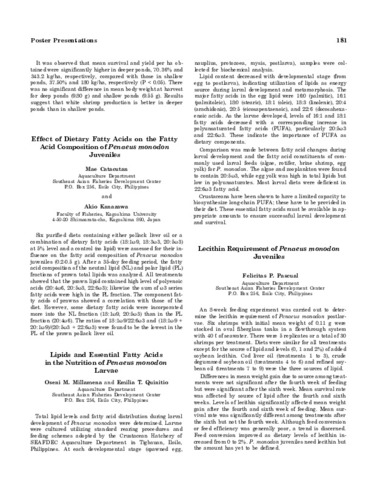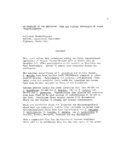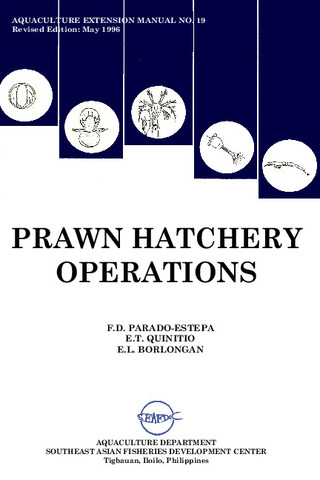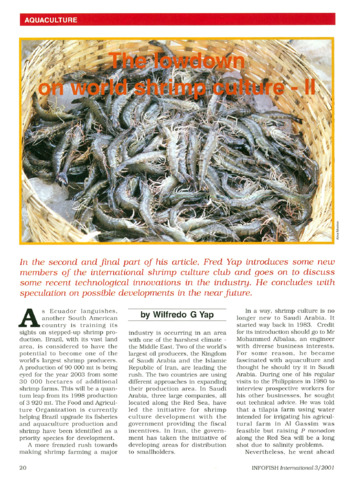Lipids and essential fatty acids in the nutrition of Penaeus monodon larvae
| dc.contributor.author | Millamena, O.M. | |
| dc.contributor.author | Quinitio, E.T. | |
| dc.contributor.editor | Taki, Yasuhiko | |
| dc.contributor.editor | Primavera, Jurgenne H. | |
| dc.contributor.editor | Llobrera, Jose A. | |
| dc.date.accessioned | 2012-04-20T03:41:12Z | |
| dc.date.available | 2012-04-20T03:41:12Z | |
| dc.date.issued | 1985 | |
| dc.identifier.citation | Millamena, O. M., & Quinitio, E. T. (1985). Lipids and essential fatty acids in the nutrition of Penaeus monodon larvae. (Abstract only). In Taki Y., Primavera J.H. and Llobrera J.A. (Eds.). Proceedings of the First International Conference on the Culture of Penaeid Prawns/Shrimps, 4-7 December 1984, Iloilo City, Philippines (p. 181). Iloilo City, Philippines: Aquaculture Department, Southeast Asian Fisheries Development Center. | en |
| dc.identifier.isbn | 9718511008 | |
| dc.identifier.uri | http://hdl.handle.net/10862/914 | |
| dc.description | Abstract only. | en |
| dc.description.abstract | Total lipid levels and fatty acid distribution during larval development of Penaeus monodon were determined. Larvae were cultured utilizing standard rearing procedures and feeding schemes adopted by the Crustacean Hatchery of SEAFDEC Aquaculture Department in Tigbauan, Iloilo, Philippines. At each developmental stage (spawned egg, nauplius, protozoea, mysis, postlarva), samples were collected for biochemical analysis. Lipid content decreased with developmental stage (from egg to postlarva), indicating utilization of lipids as energy source during larval development and metamorphosis. The major fatty acids in the egg lipid were 16:0 (palmitic), 16:1 (palmitoleic), 18:0 (stearic), 18:1 (oleic), 18:3 (linolenic), 20:4 (arachidonic), 20:5 (eicosapentaenoic), and 22:6 (docosahexa-enoic acids. As the larvae developed, levels of 16:1 and 18:1 fatty acids decreased with a corresponding increase in polyunsaturated fatty acids (PUFA), particularly 20:5ω3 and 22:6ω3. These indicate the importance of PUFA as dietary components. Comparison was made between fatty acid changes during larval development and the fatty acid constituents of commonly used larval feeds (algae, rotifer, brine shrimp, egg yolk) for P. monodon. The algae and zooplankton were found to contain 20:5ω3, while egg yolk was high in total lipids but low in polyunsaturates. Most larval diets were deficient in 22:6ω3 fatty acid. Crustaceans have been shown to have a limited capacity to biosynthesize long-chain PUFA; these have to be provided in their diet. These essential fatty acids must be available in appropriate amounts to ensure successful larval development and survival. | en |
| dc.language.iso | en | en |
| dc.publisher | Aquaculture Department, Southeast Asian Fisheries Development Center | en |
| dc.subject | Developmental stage | en |
| dc.subject | Penaeus monodon | en |
| dc.title | Lipids and essential fatty acids in the nutrition of Penaeus monodon larvae | en |
| dc.type | Conference poster | en |
| dc.citation.spage | 181 | |
| dc.citation.conferenceTitle | Proceedings of the First International Conference on the Culture of Penaeid Prawns/Shrimps, 4-7 December 1984, Iloilo City, Philippines | en |
| dc.subject.asfa | biochemical composition | en |
| dc.subject.asfa | fatty acids | en |
| dc.subject.asfa | shrimp culture | en |
| dc.subject.scientificName | Penaeus monodon | en |






